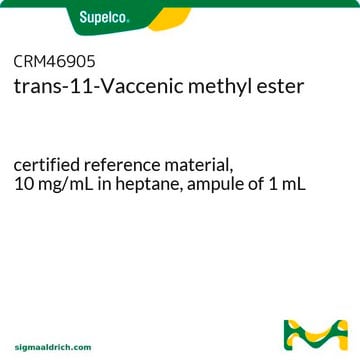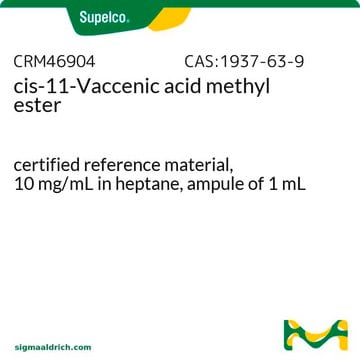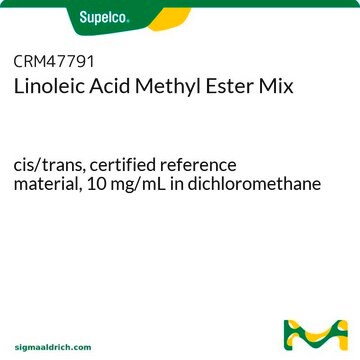Kluczowe dokumenty
46903
trans-9-Octadecenoic methyl ester
10 mg/mL in heptane, analytical standard
Synonim(y):
Methyl elaidate, Elaidic acid methyl ester, Methyl trans-9-octadecenoate
About This Item
Polecane produkty
klasa czystości
analytical standard
Certyfikat analizy
certificate of analysis is enclosed in each package.
opakowanie
ampule of 1 mL
stężenie
10 mg/mL in heptane
metody
HPLC: suitable
gas chromatography (GC): suitable
gęstość
0.871 g/mL at 20 °C (lit.)
Format
single component solution
temp. przechowywania
−20°C
ciąg SMILES
CCCCCCCC\C=C\CCCCCCCC(=O)OC
InChI
1S/C19H36O2/c1-3-4-5-6-7-8-9-10-11-12-13-14-15-16-17-18-19(20)21-2/h10-11H,3-9,12-18H2,1-2H3/b11-10+
Klucz InChI
QYDYPVFESGNLHU-ZHACJKMWSA-N
Szukasz podobnych produktów? Odwiedź Przewodnik dotyczący porównywania produktów
Zastosowanie
zastąpiony przez
Hasło ostrzegawcze
Danger
Zwroty wskazujące rodzaj zagrożenia
Zwroty wskazujące środki ostrożności
Klasyfikacja zagrożeń
Aquatic Acute 1 - Aquatic Chronic 1 - Asp. Tox. 1 - Flam. Liq. 2 - Skin Irrit. 2 - STOT SE 3
Organy docelowe
Central nervous system
Kod klasy składowania
3 - Flammable liquids
Klasa zagrożenia wodnego (WGK)
WGK 2
Temperatura zapłonu (°F)
24.8 °F
Temperatura zapłonu (°C)
-4 °C
Wybierz jedną z najnowszych wersji:
Masz już ten produkt?
Dokumenty związane z niedawno zakupionymi produktami zostały zamieszczone w Bibliotece dokumentów.
Nasz zespół naukowców ma doświadczenie we wszystkich obszarach badań, w tym w naukach przyrodniczych, materiałoznawstwie, syntezie chemicznej, chromatografii, analityce i wielu innych dziedzinach.
Skontaktuj się z zespołem ds. pomocy technicznej












